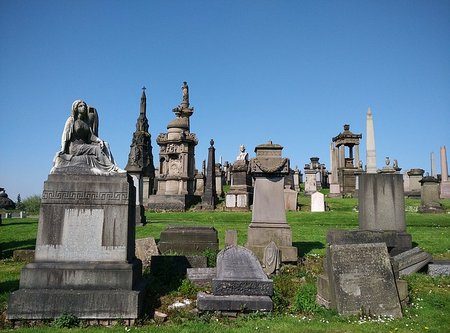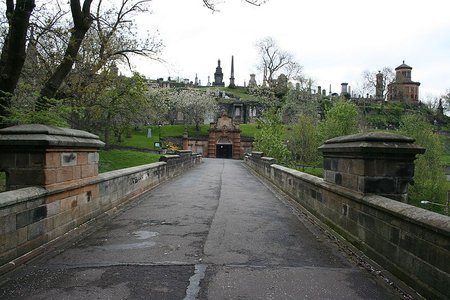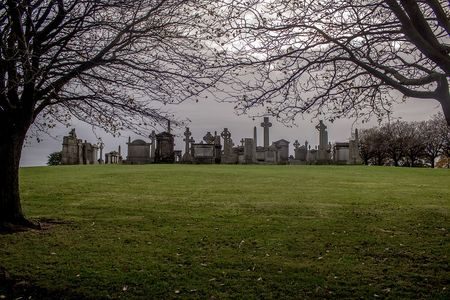One of the most beautiful cemeteries in the world, Glasgow Necropolis has commanded a lot of attention because of its architectural beauty and aesthetics. A poignantly named Bridge of Sighs leads to the Necropolis via a couple of ornate gates. Inside, you will be surprised to see the vast number of memorials (some 5,000 of them) that include memorials to the soldiers martyred in the Korean War, tributes to the Glaswegian bearers of the Victorian cross etc. and some poignant sections like memorials to stillborn children buried with their mothers.
The cemetery leads visitors from the west to the east in the traditional freemason style and at the summit of the hill is the John Knox statue and the largest and best monuments literally laid out in the manner of icing on the cake. The necropolis is not a glamorous attraction and while many will find it odd to visit a cemetery on their holiday… this is a place that delivers many important lessons on history and culture. The Necropolis was (and still is) a testimony to the immense wealth and prosperity of Glasgow in the Victorian ship building times. A prosperity that made its citizens wanting to showcase how good their living standards were even after death!!!

History
In 1650 Merchants House brought a part of the Western Craig’s estate and then planted it with a substantial number of Fir trees… this was eventually called the Fir Park. Around 1804 Elm trees and willow trees replaced the dying Firs and this place became a Victorian arboretum and park. Around 1825 the foundation stone of the park i.e. the famous John Knox monument was laid down. Pere Lachaise of Paris… the most ambitious cemetery in the world and the iconic Bridge of Sighs in Venice were the inspiration behind Glasgow’s Necropolis.
A wealthy network of Glasgow based traders, social entrepreneurs and wealthy influencers decided to create a Necropolis that reflected the brilliance and wealth of Glasgow. In 1831 John Strang (chairman of merchant’s house) wrote about how the Fir Park could be converted into a Pere la Chaise cemetery. David Hamilton (architect) and Stuart Murray (Botanical Gardens curator) conducted a feasibility study for the creation of Necropolis. Finally, like most important constructions in UK… a competition was announced for designs of converting Fir Pak into a cemetery.
About 16 plans were exhibited on the exhibition Rooms in Argyll Arcade and George Mylne (landscape gardener) was put in charge of the project. The Necropolis was planned to be a park and not a typical plot style cemetery and it quickly caught the fancy of the rich and famous of Glasgow. The creation of the Necropolis happened in the Victorian era when Glasgow had established itself as the 2nd city of the empire all thanks to the luscious business it was doing on the shipbuilding industry on the Clyde. This was the time when Glasgow enjoyed thriving international trade with the Crown and was one of the most prosperous places on earth. Citizens of Glasgow thought about celebrating these accomplishments and in accordance with the Victorian fashion of obsessing over the dead… their thoughts zeroed in on this cemetery.
The highly decorative Victorian style burial ground was designed by a landscape designer assisted by architects. It was originally thought that catacombs connected to the Necropolis would run inside the belly of the huge hill overlooking the Glasgow cathedral because the practice of grave robbery (robbers digging up graves and selling bodies to anatomists) was rampant at that point. However, the anatomy act of 1832 brought in stipulations that made grave digging unprofitable and thus the idea of catacombs was also abandoned.
It was around this time that the cemetery’s first burial took place… Joseph Levi a Jewish jeweller. The Glasgow Necropolis has about 50,000 residents but only about 5,000 of them have a memorial in their name. Such was the popularity of the Necropolis that it was expanded thrice in its lifetime; 1860, 1877 and 1892 and by that time Glasgow’s City of Dead covered nearly 37 acres. Contrary to the usual morbid picture of a cemetery, this one is designed to inspire and celebrate and definitely not to depress.
The John Knox memorial at the Glasgow Necropolis is the first statue ever of John Knox in Scotland (famous Scottish reformer) and the memorial statue was the original foundation stone of the Necropolis. Strangely John Knox is not buried here… it was Robert Stevenson Mc Gill’s idea (professor of theology Glasgow University) to have the John Knox statue erected here. All leading designers of those times like Alexander ‘Greek’ Thomson, Charles Rennie Macintosh and JT Rochead worked on the Necropolis monuments.
Even today the Necropolis is full of mystery and myths. Charles Rennie Mackintosh (Scotland’s eccentric and gifted architect) is a name associated with the Necropolis but he was buried in London. The association is because of a striking Celtic cross designed by Mackintosh for the grave of his friend Andrew McCall (important officer of Glasgow police force).
Unlike most other cemeteries, Necropolis kept exact records of the deceased including profession, age and sex. If you visit the Mitchell library you will find exactly how well documented Glasgow’s City of the dead is… each name, date and gender is recorded along with personal particulars and cause of death. The city of the dead is a fine example of diversity in religion and culture…you will find protestants, Quakers, Lutherans, Jews (the latter are buried in a separate plot in keeping with their religious sentiments)… all peacefully existing together. Since 1966 the Glasgow City council has been managing the Necropolis and it’s now one of the most visited attractions of Glasgow.
What To See & Do
Necropolis is currently hot in news because of its connection with freemasonry. For the record Freemasonry refers to the practices and teachings of the secret fraternal order of free and accepted masons… the world’s biggest secret society (estimated to be around 6 million today). Historians like Ronnie Scott have expressed their strong belief that there are unseen symbols and codes in the 19th century cemetery.
The Necropolis was supposed to be designed by freemasons who were also members of the merchants House of Glasgow. For example, visitors entering the cemetery cross a bridge and pass through twin pillars before they ascend a hill. This path shows the masonic journey from the west to east. Incidentally Freemasonry is believed to have Scottish roots with earliest remains of a masonic lodge in Edinburgh dating back to 1598. Jock Stein, Robert Burns, Walter Scott were all noted Scottish freemasons.
The focus on Freemasons surged high after the Dan Brown novel Da Vinci Code released in 2003… its sections on code breakers and history sleuths brought hundreds of tourists and wannabe sleuths here. The Royal arch and the carvings on the tombs are believed to contain cryptic messages… see if you can decipher a couple of them yourself.
There are 32 Grade ‘A’ listed monuments inside the Necropolis. The most outstanding statue here is the Doric memorial column on the hilltop containing a 12 feet John Knox statue. Don’t miss capturing the view from here… a birds eye shot of Glasgow with the cathedral on one side and Royal Infirmary on the other side. The Tennent Caledonian breweries which still fill the air of Necropolis with a drunken fragrance, is also visible from this point.
Then there is a big tiered octagonal Norman styled building that’s the Mausoleum of Major Archibald Douglas Moteath. Look out for the tomb of actor John Alexander (Royal Theatre) … it has a stage scene with two (now disfigured) statues of comedy and tragedy. Then there is the Houldsworth mausoleum with flanking angels and hope, charity and faith visible inside the mausoleum. The tomb of Charles Tennant has a seated marble statue of Charles Tennant at St Rollox while the monument of William Mc Gavin has an interesting statue.
There are some tombs like the tomb of Walter Macfarlane of Saracen foundry which are completely different; this one has an art nouveau portrait panel. Most monuments have moral figures flanking them and you can see life with a torch standing on the monument to Peter Lawrence while Hope and Resignation look down on the statue to Mrs Margaret Montgomerie. The mausoleum of Major Archibald Douglas Monteath, the Blackie publishing family tomb and the tomb to Mrs Margaret Montgomerie are notable attractions. Tombs of Provosts and Commonwealth service personnel also lie inside the cemetery.
Look towards the top level of the Necropolis… there is angel here who stares down at the Glasgow city scape. The inscription on her stand is particularly intriguing “We shall all be changed in a moment, in the twinkling of an eye, at the last trump”. There are other angels in the Necropolis… but some have broken wings and some have lost the golden shine on their halos. There are some pretty cherubs gracing tombs and it’s all very photogenic though it can make you wonder about the less than perfect maintenance.
There is a section in the necropolis dedicated towards families buried together. There are entire families with infants, children and young adults buried together and there are dates inscribed with the tombs. It’s easy to do the maths and calculate the overwhelming number of women who used to die during childbirth and kids who used to die early in childhood due to malnourishment or illness. It’s heartening however to think of how medical science has progressed since those days. This and the memorial to martyrs in Korean War and the memorial to Victoria Cross recipients lie between the gates of the cemetery and the ‘Bridge of Sighs’.
Animal lovers will love the often overlooked collection of living beings in the Necropolis. You will surely see pipistrelle bats, foxes, grey squirrels and roe deer across the 37 acres of green space. There is also a wide variety of butterflies, birds and insects and it’s a pleasure to watch them and try photographing them. Glasgow’s Friends of Necropolis Association has discovered previously undiscovered (in Scotland) insect species here like American spider (Rugathodes sexpunctatus), millipede (Anamastigona pulchella), and Eumerus funeralis. There are also 180 species of flowering plants inside the Necropolis.
Once you are done exploring the necropolis don’t forget to walk on the Bridge of Sighs. This structure was built in 1833 by James Hamilton and it originally bridged the Molendinar Ravine and joined the Cathedral Square to new Necropolis. The Bridge of Sighs was so named as lots of funeral processions used to cross the bridge when the dead travelled to their very own ‘city of the dead’. Glasgow was so proud of its Bridge of Sighs (as it was supposed to be one of the most magnificent sights in UK at that point) that the bridge had a cavity hollowed into the bridge’s capsule and a time capsule was placed inside. In this historic phial you will be able to discover almanacs, old coins, technical maps and the actual draft signed for the construction of the bridge.

There is an actual treasure under the Bridge of Sighs. The ravine under the bridge doesn’t exist anymore… there is a road there now. There are three arches that used to let walkways pass through the bridge and they are still partially visible though they are partly filled by the banks dug out from the road. Notice the inscription ‘the adjoining bridge was erected by the merchants house of Glasgow’ followed by a message about the greater purpose of the cemetery and then the words ‘A.D. MDCCCXXXIII’ and the quote “Blessed is the man who trusted in God and whose hope the Lord is”.
The main doors of the Necropolis are in Castle Street behind St. Mungo’s museum of religious life and art and they have a flight of stairs which is easy to navigate. However, the other parts of the Necropolis have accessibility issues… you need to be fit to explore this place. It’s not allowed to touch any part of the architecture as this is a historic site. The ground is soft mud that has been weathered by constant rain and requires attention while walking. The stairs and entrances are old and fairly derelict and will require careful handling.
If you take a private tour of the Necropolis then you may be guided to reserved toilets. For general tourists there are no toilet facilities apart from nearby St. Mungo Museum. The museum is closed on Mondays and closes on other days at 5pm
It’s easy to imagine the Necropolis with sinister vibes and an Edgar Allen Poe novel feel with bats flying around Gothic tombs. But on a closer look it’s also easy to see its lighter side… children are found playing about and chasing squirrels and butterflies. Often you will find avid readers nestling on green corners with a book in their hands. Herein lies the charm of necropolis that doesn’t regard death as the end of all joy in life.

Tours & Timings
Every weekend i.e. Saturday and Sunday general 2 hour walking tours are organised mostly in the afternoon (2.00 p.m.). These tours sell out pretty fast and are conducted by expert guides… the names of the guides and other details are mentioned on the Friends of Glasgow Necropolis website. If you really like eerie stuff then try opting for the Friday twilight tour. It lasts for an hour but is conducted just before dusk and usually features visits to the tombs of the most famous inventors, artists, writers and anatomists.
Email: [email protected] mentioning the tour that you wish to book and the number of seats.
Phone: 07971 437034.
Friends of Glasgow Necropolis also conduct private tours and these can be completely customised. You need to prebook on the above given number. Keep an eye on the walking tours section of the Official Friends of Glasgow Necropolis website as they keep offering different themed walks like war memorial walks, celebrity grave walks etc. Do remember that the Glasgow Necropolis spans around 37 acres and there is quite a lot of walking involved in tours. You can stop and take rest but may not use the tombs or any memorial stone as support or a seat. You can however sit on the low fence surrounding the Necropolis or on any shaded corner of the cemetery (on the ground). Carry your own bottle of water and wear sturdy shoes.
You can do a self-guided tour of the Necropolis after buying the guidebook (Easy to follow guide with full colour photos by Ruth Johnston) as it details 60 of the best monuments and makes your tour easy. You can easily buy this book online from the books section of Friends of Glasgow Necropolis website.
Open Hours
The Glasgow Necropolis is open from 7 a.m. to dusk, so the closing times in winter can be as early as 4.30 p.m.
How To Reach
Glasgow Necropolis lies at the eastern edge of the city centre and its main gates lie behind St Mungo’s Museum of Religious Life and Art. There are two other gates of the Necropolis… one at Wishart Street and the other off John Knox Street opposite Cathedral House Hotel.
Nearby is the Glasgow Cathedral so many people who visit the cathedral also visit the Necropolis on the same day. The Glasgow Cathedral has excellent signage and all you need to do to walk to the Necropolis from Queen Street Station is to walk east along George Street following signage for the Glasgow Cathedral (roughly a 15 minute walk). You will require only about 8 minutes to walk to Glasgow Necropolis from High Street Station. Nearest subway station to the Necropolis is at Buchanan Street that’s a 20 minute walk away.
Address: 50 Cathedral Square, Glasgow G4 0UZ
Glasgow Necropolis website
After you are done with the Necropolis tour you could walk straight into Cathedral house… a classy pub on Cathedral Square. Or you could get some gourmet coffee brews at Empire Coffee on Tardis Cathedral Square. Then there is Mc Cune Smith Café serving traditional British and Scottish snacks on Duke Street and Baked Pizza at Taglio serving authentic Italian Pizza. High street (High Street Sandwich Co and Friends Chinese Café) and Ingram Street (Swadish, Qua and Italian Kitchen) are full of cute restaurants and cafes.
 A travel addict. Still celebrating the day when he quit his high-profile corporate job to pursue his passion for travel writing.
A travel addict. Still celebrating the day when he quit his high-profile corporate job to pursue his passion for travel writing.